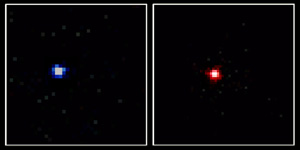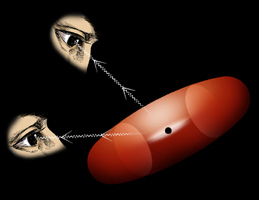May 29, 2001
CXC PR: 01-09
Using NASA's Chandra X-ray Observatory, astronomers have made the first detailed study of a peculiar type of quasar that is shrouded in clouds of gas and dust flowing outward at millions of miles per hour. The results support the idea that this outflow is a common feature of all quasars, highly active supermassive black holes that give the illusion of being different when viewed from various angles.
Quasars are some of the most energetic and distant known objects in the universe. Most quasars are extremely bright in optical light, but about 10 percent appear 'shrouded,'or hidden, by absorbing clouds of gas and dust. In addition to these obscuring clouds, the same subset of quasars shows evidence of extremely energetic winds blasting outwards from the central regions.
Astronomers have debated whether these shrouded quasars represent an early evolutionary stage of black holes when they vigorously consume matter, or whether these energetic outflows are present in all quasars, but detectable only when viewed in certain orientations.
"Because high-energy X-rays can pierce through these clouds, we can use Chandra to observe close to the underlying black hole," said Paul Green of the Harvard-Smithsonian Center for Astrophysics and lead author of a paper to appear in The Astrophysical Journal. "Looking through these veils, we find that the extremely hot gas around these supermassive black holes shines just the same way as in non-shrouded quasars."
Green and his colleagues used Chandra to survey ten shrouded quasars through a process known as spectroscopy, the study of how atoms absorb and emit light. X-ray spectroscopy provides astronomers with a unique ability to "fingerprint" very high-energy objects at great distances.

These two Chandra images demonstrate the different appearances of "normal" and "shrouded" quasars.
Credit: NASA/CfA/P.Green et al.
"Chandra is beginning to show us that these quasars are all the same underneath, regardless of what they are wearing on the outside," said Tom Aldcroft, another member of the team from the CfA.
"Our work lends weight to the theory that all quasars possess obscuring donuts of thick gas and dust," said Smita Mathur of The Ohio State University. "However, the difference is that some 'normal' quasars are being observed through the top into the donut hole, while the shrouded ones are being seen through the side."
This work by Green and collaborators confirms earlier suggestions based on observations with the ASCA satellite by their team, and by a Penn State University team led by Sarah Gallagher. Gallagher is currently working to extend these results with Chandra, which is also revealing the familiar, but previously hidden, X-ray emission from several other shrouded quasars. Their results, along with other observations of more distant and hence younger quasars of this type, indicate that the "donuts" may be more common, or perhaps thicker in younger quasars.
The research team led by Green used the Advanced CCD Imaging Spectrometer (ACIS) instrument to survey 10 different quasars. The exposure times of these observations ranged from 1,300 to 5,400 seconds.
ACIS was built for NASA by the Massachusetts Institute of Technology, Cambridge, MA, and Pennsylvania State University, University Park. NASA's Marshall Space Flight Center, Huntsville, AL, manages the Chandra program for the Office of Space Science, Washington, DC. TRW, Inc., Redondo Beach, California, is the prime contractor for the spacecraft. The Smithsonian's Chandra X-ray Center controls science and flight operations from Cambridge, MA.
Images associated with this release are available on the World Wide Web at:
MEDIA CONTACTS
Steve Roy
Marshall Space Flight Center, Huntsville, AL
Phone: 256-544-6535
Megan Watzke
Chandra X-ray Observatory Center, CfA, Cambridge, MA
Phone: 617-496-7998



